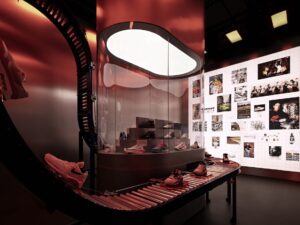Chic women who read? Join the club.
Fashion and literature share an intricate relation. Fashion as a tool of contextualizing has been used by authors from all walks of life to set the decor of a situation. Fashion in description informs the reader on the personality of the characters, time, and place. Fashion is present in all genre of texts, deconstructed and analysed. From the pen of the likes of Sonia Rykiel or Karl Lagerfeld, fashion writes itself.
The house of Chanel has always cherished literary references in its designs: Gabrielle Chanel was a vivid reader, Karl Lagerfeld a collector known for his library, even Virginie Viard’s first show took place in a library. Far from the superficiality of the appearances, literary hints can even be find in the garments, layering of sheer fabrics in reference of the pages of a book in the Fall 2019 couture collection, and models reading books on the runway in numerous Chanel show from the 90’s.
The new face of Chanel, Charlotte Casiraghi, Monaco’s royal and socialite, invites us to Rue Cambon -historic ateliers of the French house- every month centered around a Chanel book club « Les rendez-vous littéraire rue Cambon » and invite women authors and lecturers to celebrate womanhood through the power of words.
The lecture is in French, but the rhythm of the prose is universal. English subtitles are available.
The second session of this bookclub, hosted by Charlotte Casiraghi, gathered the author Camille Laurens, actress Lyna Khoudri and literature historian Fanny Arama for a refreshing reflexion on the female condition through the study of Camille Laurens writings.
When questioned by the emblematic fashion journalist Loïc Prigent -present to the rendez-vous Rue Cambon- on their favourite book about Chanel, the panel unanimously answered « la femme qui lit »: a publication gathering all annotations in various books made by the hand of Gabrielle Chanel herself and some of her eminent friends. La femme qui lit, the woman who read. I feel like I might know her, I’ve seen her devouring the last Fräulein at the kiosk in Kurfürstendamm, waiting for her train. Or was it in les jardins du Luxembourg, enjoying Proust during her sunbath? We all know and acknowledge those chic woman who read. She inspires many. She inspires us.
Today we wish to pay hommage to the women in literature.
Manon of the Spings, Marcel Pagnol
Manon of the Spings is a traditional oral literature from the rural southern France, from the pen of Marcel Pagnol. We learn the fate of Manon who explores the condition of being a women, revengeful against the men who made her suffer. A haunting story, a Provencal legend of vengeance, exacted by a mysterious shepherdess.
Pagnol portyaed the countrymen in a story of struggle for life, of crime and punishment, of betrayal and revenge, and of judgment and forgiveness. This moving story has a keen understanding of the Provencal countryside and its people and ambience. Manon is a nobody and yet she is a heroine, determined to punish Ugolin who is responsible for the death of her father. Ugolin, who is desperately in love with her, will suffer the consequences of his acts by being rejected by Manon. Love is followed by madness as Ugolin sews pieces of Manon’s dress to the flesh of his torso. Fashion relic at its climax.
– Marien Brandon, Contributor
Trick Mirror, Jia Tolentino.
It shouldn’t come as a surprise that we are all delusional. Some of us politically, others personally, most of us both. But that doesn’t have to be a bad thing, as long as we are aware of it. In nine interlinked essays author Jia Tolentino writes about her own coming out of age in the confusing landscape of today. Humorous and fiercely she shares her experiences on ecstasy, so called „self-optimization“ and an obsession with extravagant weddings. A truly eye-opening and entertaining read.
– Ann-Kathrin Lietz, Fashion Editor
A Man’s Place, Annie Ernaux
Objectively, almost unemotionally, Annie Ernaux describes in “A Man’s Place” the circumstances in which her father had to live – a life subjected to necessity. The slim book is the document of a liberation that does not remain contradictory. Ernaux positions herself more and more in an intellectual world in Paris that is completely alien to that of her father. One of the first works of autosociobiography, the author tries to draw closer to the life of her father, without becoming sentimental. A book cannot capture everything, only fragments of memory. “A Man’s Place” is, however, one of the most beautiful reflections on the origins and social circumstances we come from.
– Antonia Schmidt, Editorial Intern

The Girls, Emma Cline
California in the 60s. Teenager Evie is bored, her parents recently got divorced and no one really cares about her. But her life changes on one summer day, when she sees them: The girls. Long untamed hair, worn-out clothes, wild laugh. Immediately Evie is fascinated and joins them. What she doesn’t know: The girls life in a commune and all follow one man, Russell. His character is based on Charles Manson, but this story isn’t about him and the murders. It’s more about Evie and her admiration for Suzanne, one of the girls. Evie is 14-years old and gets into a maelstrom of cohesion, dependency, lack of will; she is insecure and seducible. This book is a special Coming-of-age story that looks with psychological sensitivity deep into a young girl’s soul.
– Hannah Sulzbach, Contributor
Valerie Valère, Le Pavillon des enfants fous.
Plagued by melancholy and loneliness, the book „Le Pavillon des enfants fous“ is created in which Valerie Valerie processes her time in a psychiatry. At the age of just 15, valère dives into the hopeless literature and creates a rousing work and insights into the despair of a young woman between unrequited confirmation from her mother and the ever deeper fall of her own person, the loss of hope.
– Carolin Becker, Junior Fashion Editor

Text by Marien Brandon
Images courtesy of Corresponding Publishing Houses



